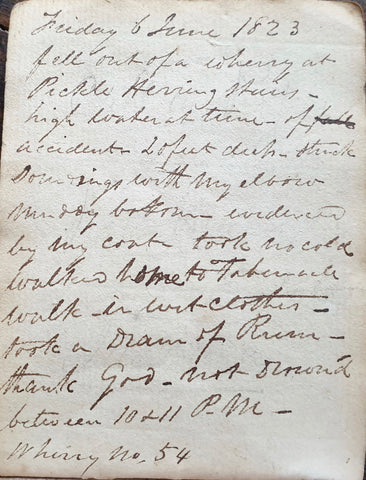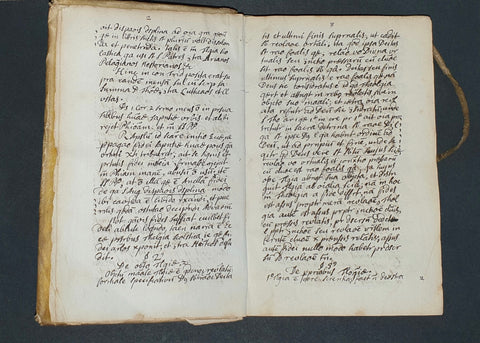[MANUSCRIPT - C.1740]. [Gibbs, Joseph]. [Epitaphs In Westmister Abbey. With Translations Of The Latin Inscriptions Into English]
[England]: [c.1740].
4to, 116 hand numbered pages, various circular hand drawn copies of funerary inscriptions, hand written in pen and ink. Original marbled paper covered card covers (rubbed; a little loss of paper covering to extremities).
The collection of funeral epigraphy has a long history and formed not only a memento mori in times where death was a more pressing presence than in our own times, but also a branch of literature in its own right and a subject for antiquarian research.
Traister in Anonymity in Early Modern England: 'What's In A Name?' explores the difference between printed and manuscript collections of epitaphs and makes us aware that manuscript collections of epitaphs “...function like a graveyard themselves. Empty spaces are filled in as the new epitaphs are acquired, just as bodies are added to a crowded churchyard or tombs to a Cathedral corner.” and thus form a highly individualistic branch of literature in their own right.
This is entirely the case with this curious indexed collection of one hundred and twenty-one transcribed epitaphs from Westminster Abbey (with English translations from Latin, Greek or Hebrew where appropriate). The compositions, which include the funerary inscriptions of notables such as Isaac Newton, William Shakespeare, John Gay, Abraham Cowley, William Camden & John Dryden, show the variance of handwriting that indicates an organic collection with composition over time.
Each entry is in a separate, numbered and ruled box, some with copies of circular funerary inscriptions and several towards the end of the manuscript with copies of the original Greek or Hebrew inscription. A lovely copy of an unusual item (stitching broken; one leaf lacking blank upper corner tip). [Ref: 1774]
We Also Recommend

![[MANUSCRIPT - C.1740]. [Gibbs, Joseph]. [Epitaphs In Westmister Abbey. With Translations Of The Latin Inscriptions Into English]](http://alastor-rare-books.myshopify.com/cdn/shop/products/20201013_162704_large.jpg?v=1602603423)
![[MANUSCRIPT - C.1740]. [Gibbs, Joseph]. [Epitaphs In Westmister Abbey. With Translations Of The Latin Inscriptions Into English]](http://alastor-rare-books.myshopify.com/cdn/shop/products/20201013_162704_compact.jpg?v=1602603423)
![[MANUSCRIPT - C.1740]. [Gibbs, Joseph]. [Epitaphs In Westmister Abbey. With Translations Of The Latin Inscriptions Into English]](http://alastor-rare-books.myshopify.com/cdn/shop/products/20201013_162712_compact.jpg?v=1602603424)
![[MANUSCRIPT - C.1740]. [Gibbs, Joseph]. [Epitaphs In Westmister Abbey. With Translations Of The Latin Inscriptions Into English]](http://alastor-rare-books.myshopify.com/cdn/shop/products/20201013_162655_compact.jpg?v=1602603424)
![[MANUSCRIPT - C.1740]. [Gibbs, Joseph]. [Epitaphs In Westmister Abbey. With Translations Of The Latin Inscriptions Into English]](http://alastor-rare-books.myshopify.com/cdn/shop/products/20201013_162729_compact.jpg?v=1602603425)
![[MANUSCRIPT - C.1740]. [Gibbs, Joseph]. [Epitaphs In Westmister Abbey. With Translations Of The Latin Inscriptions Into English]](http://alastor-rare-books.myshopify.com/cdn/shop/products/20201013_162900_compact.jpg?v=1602603425)
![[MANUSCRIPT - C.1740]. [Gibbs, Joseph]. [Epitaphs In Westmister Abbey. With Translations Of The Latin Inscriptions Into English]](http://alastor-rare-books.myshopify.com/cdn/shop/products/20201013_162930_compact.jpg?v=1602603425)


![[HORTICULTURE] [Maitland, Alfred]. [Hand-drawn Garden Plan with Manuscript Note For An English Regency Cottage Garden].](http://alastor-rare-books.myshopify.com/cdn/shop/files/9CFF5979-0FF5-41B1-897C-88E2F0D89D43_1_201_a_large.jpg?v=1692264824)
![[Manuscript Correspondence Concerning The Operations Of the Liverpool Apothecaries Company]..](http://alastor-rare-books.myshopify.com/cdn/shop/files/82125194-6397-4BF8-BEFB-3940AB9887E2_1_201_a_e236b497-07f8-4d78-b4f5-d59c662dec55_large.jpg?v=1692264704)
![[MANUSCRIPT]. Cathcart, Robert. **A SCOTTISH INSURANCE AGENT IN AYRSHIRE**](http://alastor-rare-books.myshopify.com/cdn/shop/files/550192CD-9D10-4252-950E-62385711950A_1_201_a_large.jpg?v=1692201783)